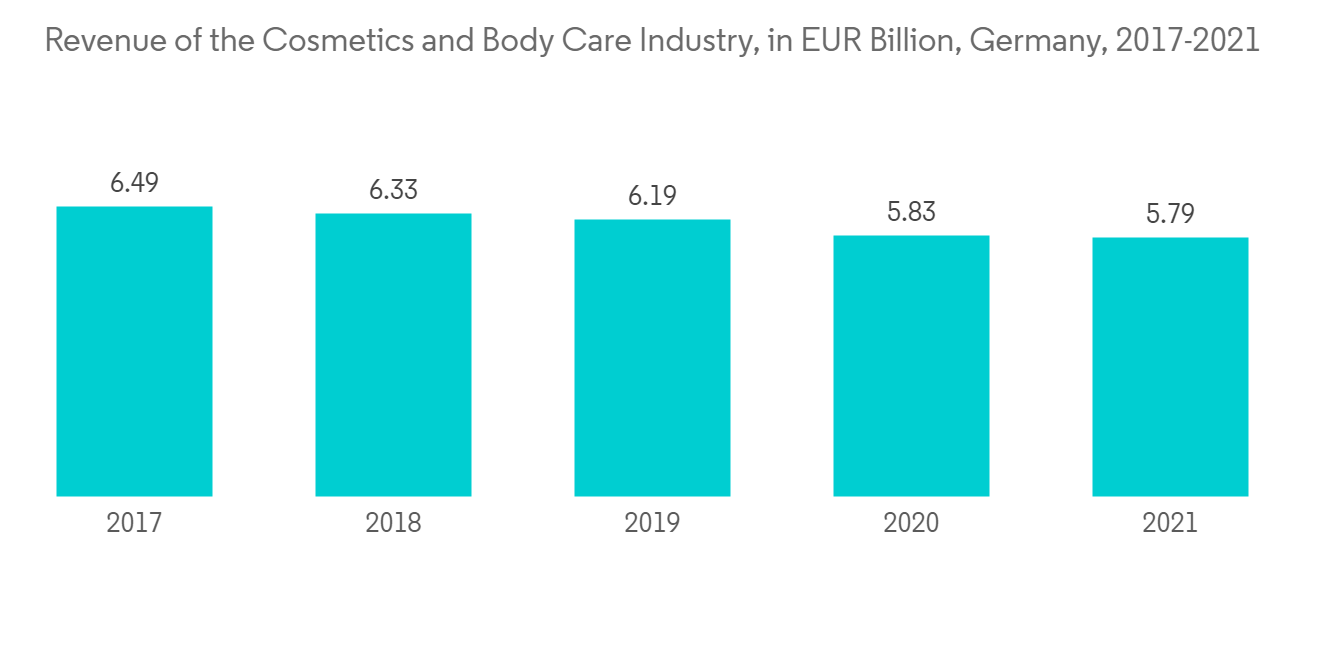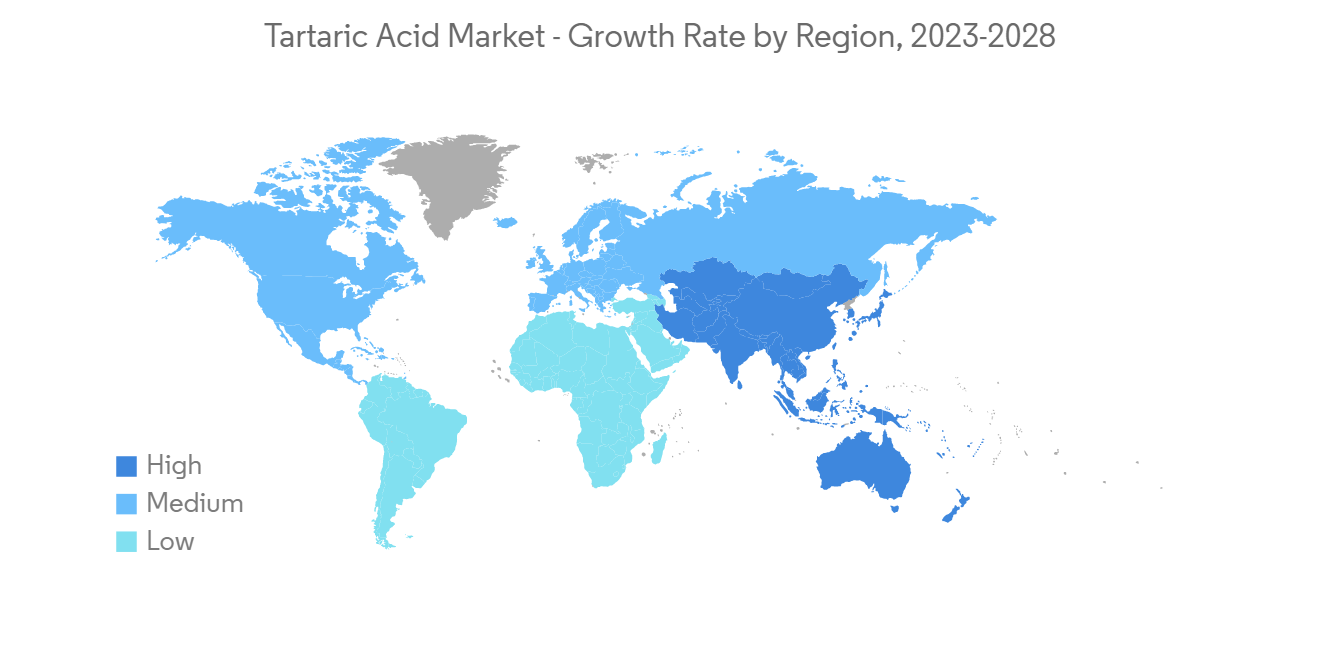 |
市場調查報告書
商品編碼
1273487
酒石酸市場 - 增長、趨勢、COVID-19 影響和預測 (2023-2028)Tartaric Acid Market - Growth, Trends, and Forecasts (2023 - 2028) |
||||||
※ 本網頁內容可能與最新版本有所差異。詳細情況請與我們聯繫。
在預測期內,酒石酸市場預計將以超過 5% 的複合年增長率增長。
COVID-19 影響了各個行業,影響了 2020 年酒石酸行業的增長。 然而,大流行後建築活動的激增推動了整個行業的增長。
主要亮點
- 從長遠來看,製藥和食品行業越來越多地採用微膠囊技術以及製藥行業不斷增長的需求是市場增長的主要驅動力。
- 越來越多的政府法規限制在食品行業中使用合成酒石酸,這可能會阻礙市場增長。
- 在利基應用中採用酒石酸可能會在未來幾年帶來市場機遇。
- 亞太地區在酒石酸市場佔據主導地位,預計在預測期內將繼續保持最高的複合年增長率。
酒石酸市場趨勢
化妝品行業需求增加
- 化妝品和個人護理產品包括身體護理和頭髮護理等各種產品。 洗髮水、護髮素、沐浴露和香皂等護膚品在這一細分市場中佔有很大份額。
- 酒石酸及其鹽類在化妝品和個人護理產品中用作 pH 調節劑。 作為護膚成分,它被認為風險低且使用安全。 它也被用作化妝品製造中的抗氧化劑。
- 個人護理行業在最終用戶行業中佔據第三大消費份額。 在全球範圍內,該行業繼續以適度的速度增長。
- 男性消費者對個人健康和外表的意識日益增強,推動了男士美容產品市場的發展。 在此背景下,各大公司都專注於為男士推出創新的新產品,並擴大產品線和客戶群。 因此,您可能會比競爭對手更具優勢。
- 根據個人護理協會 Cosmetic Europe 的數據,化妝品和個人護理行業每年至少為歐洲經濟貢獻 290 億歐元(340 億美元)。 德國是歐洲最大的化妝品市場之一。 2021 年,德國身體護理和化妝品行業的銷售額將接近 7.9 億歐元(9.2 億美元)。
- 亞太地區佔全球美容和個人護理市場的 40% 以上。 產量已達到很高的水平,使其成為向美國、加拿大和奧地利等發達國家出口化妝品和個人護理產品的中心基地。
- 中國是世界第二大化妝品市場,並正在成為世界上最大的化妝品和護膚品市場。 2021-2022年,包括彩妝、護膚、護髮、個人衛生等多個行業的中國化妝品護膚品市場將實現增長。 此外,人口的持續增長也是拉動該國化妝品需求的一個因素。 此外,人口的持續增長也是拉動該國化妝品需求的一個因素。
- 2022 年,化妝品零售額將達到 3936 億元人民幣(610 億美元)。 隨著中國二、三大城市對化妝品的需求持續增長,預計未來幾年化妝品零售將保持增長勢頭。
- 由於上述所有因素,預計酒石酸市場在預測期內將會增長。

亞太地區主導市場
- 亞太地區在酒石酸市場中所佔份額最大。 隨著對加工食品和食品飲料的需求增加,新興市場食品和飲料中酒石酸的消費量預計將擴大。
- 由於中國和印度等最大消費國的存在,該地區對酒石酸的需求顯著增長。 此外,酒石酸在醫藥行業的應用激增也是推動市場增長的關鍵因素之一。
- 印度在全球製藥領域佔有重要地位。 印度是世界上最大的仿製藥生產國。 印度製藥業佔全球各種疫苗需求的50%以上、美國仿製藥的40%和英國所有藥物的25%。
- 此外,日本的製藥業是世界上最大的製藥業之一,超過了美國和中國。 到 2021 年,日本的倫理藥品總產值約為 9.2 萬億日元(870 億美元),低於上一年的約 9.3 萬億日元(880 億美元)。
- 亞太地區是化妝品和個人護理行業最大的市場,約佔全球化妝品市場份額的 40%,並且隨著新興國家/地區個人護理意識的增強而增長。 印度青少年和中年人的化妝品消費量呈上升趨勢,這主要是由於人們對自我保健的興趣日益濃厚。
- 化妝品和個人護理行業是印度增長最快的消費品市場之一,對美國公司來說具有很高的市場准入潛力。 該國的個人護理和化妝品行業增長強勁,增加了零售和精品店的貨架空間。
- 在印度,到 2022 年,化妝品、肥皂、盥洗用品和精油的出口額將達到約 29 億美元。 較上年明顯增加。
- 預計在預測期內,所有這些因素都會推動該地區的酒石酸市場。

酒石酸行業概況
酒石酸市場因其性質而分散。 市場領導者包括 Distillerie Mazzari S.p.A、AUSTRALIAN TARTARIC PRODUCTS、Anhui Hailan Biotechnology、The Tartaric Chemicals Corporation 和 Industria Chimica Valenzana I.C.V. SpA(排名不分先後)。
其他福利:
- Excel 格式的市場預測 (ME) 表
- 3 個月的分析師支持
內容
第一章介紹
- 調查先決條件
- 本次調查的範圍
第二章研究方法論
第 3 章執行摘要
第四章市場動態
- 主持人
- 亞太和拉丁美洲地區對葡萄酒的需求不斷增長
- 越來越多地採用微囊技術在製藥和食品行業
- 製藥行業的需求增加
- 約束因素
- 加強有關限制在食品工業中使用合成酒石酸的政府法規
- 工業價值鏈分析
- 波特的五力分析
- 供應商的議價能力
- 消費者的議價能力
- 新進入者的威脅
- 替代品的威脅
- 競爭程度
第 5 章市場細分
- 類型
- 天然酒石酸
- 合成酒石酸
- 用法
- 防腐劑/添加劑
- 瀉藥
- 中級
- 其他用途
- 最終用戶行業
- 食物和飲料
- 醫藥
- 化妝品
- 建築
- 其他最終用戶行業
- 地區
- 亞太地區
- 中國
- 印度
- 日本
- 韓國
- 其他亞太地區
- 北美
- 美國
- 加拿大
- 墨西哥
- 歐洲
- 德國
- 英國
- 法國
- 意大利
- 西班牙
- 其他歐洲
- 南美洲
- 巴西
- 阿根廷
- 其他南美洲
- 中東和非洲
- 沙特阿拉伯
- 南非
- 其他中東和非洲地區
- 亞太地區
第六章競爭格局
- 併購、合資、合作、合同等。
- 市場份額 (%)/排名分析
- 主要公司採用的策略
- 公司簡介
- ATP Group
- Anhui Hailan Bio-technology Co., ltd
- AUSTRALIAN TARTARIC PRODUCTS
- Changmao Biochemical Engineering Company Limited
- Dastech International Inc.
- Derivados Vinicos S.A.
- Distillerie Mazzari S.p.A
- Giovanni Randi SpA
- Industria Chimica Valenzana I.C.V. SpA
- Ningbo Jinzhan Biotechnology Co.,Ltd.
- Omkar Speciality Chemicals Ltd
- Tarac Technologies
- Tartaros Gonzalo Castello
- The Tartaric Chemicals Corporation
- Vinicas
第七章市場機會與未來趨勢
- 將酒石酸用於利基應用
- 其他商業機會
The market for tartaric acid is projected to register a CAGR of more than 5% during the forecast period.
COVID-19 impacted various industries, affecting the tartaric acid industry growth in 2020. However, the surging construction activities post-pandemic propelled the overall industry growth.
Key Highlights
- Over the long term, the significant factors driving the studied market growth are increased microencapsulation adoption across pharmaceuticals and food industries and rising demand from the pharmaceutical industry.
- Increasing government regulations for restricting synthetic tartaric acid use in the food industry will likely hinder the market growth.
- Adopting tartaric acid in niche applications will likely create opportunities for the market in the coming years.
- The Asia-Pacific region is expected to dominate the tartaric acid market and will likely witness the highest CAGR during the forecast period.
Tartaric Acid Market Trends
Increasing Demand from the Cosmetics Industry
- Cosmetics and personal care products include a variety of body care, as well as hair care products. Shampoos, hair conditioners, body washes, soaps, and other skincare products, occupy a significant share of the segment.
- Tartaric acid and its salts are used as pH adjusters in cosmetics and personal care products. It is considered a low-risk and safe-to-use ingredient for skincare. It is also used as an antioxidant in the production of cosmetics.
- The personal care segment accounts for the third-largest consumption share in end-user industries. Globally, this segment is growing at a moderate rate.
- An increasing consciousness catalyzed the male grooming products market growth among male consumers of personal wellness and appearance. Owing to this factor, key players are focusing on launching new and innovative products for men to increase their product offerings and customer base. It may give them an edge over their competitors.
- According to Cosmetic Europe, the personal care association, the cosmetics and personal care industry brings at least EUR 29 billion (USD 34 billion) in added value to the European economy annually. Germany is one of the biggest cosmetics markets in Europe. In 2021, the German body care and cosmetics industry generated almost EUR 790 million (USD 920 million) in revenue.
- The Asia-Pacific region accounts for over 40% of the global beauty and personal care marketplace. The production reached very high levels, thus becoming a central hub for exporting cosmetics and personal care products to developed nations, such as the United States, Canada, and Austria.
- China is the world's second-largest cosmetics market and emerging as the largest market in cosmetics and skin care products globally. The Chinese cosmetics and skin care market, which includes various industries such as makeup, skincare, hair care, and personal hygiene, experienced growth in 2021-2022. Furthermore, the continuous population growth is another factor fueling the demand for cosmetics products in the country. It, in turn, is augmenting the growth of the market studied.
- In 2022, the retail sales value of cosmetic products reached CNY 393.6 billion (USD 61 billion). As the demand for cosmetic products expands further in second-and third-tier cities of China, cosmetics retail is expected to maintain its growth momentum in the coming years.
- The tartaric acid market will likely grow during the forecast period due to all the factors above.

Asia-Pacific Region to Dominate the Market
- Asia-Pacific region accounted for the largest share of the tartaric acid market. Tartaric acid consumption in foods and beverages in developing markets is expected to grow, along with the increasing demand for processed food and beverages.
- The demand for tartaric acid in the region is growing significantly due to the presence of the largest consuming countries, such as China and India. The surging application of tartaric acid in the pharmaceutical industry is also one of the key factors driving the market growth.
- India holds a significant position in the global pharmaceuticals sector. India is the largest producer of generic drugs in the world. The Indian pharmaceutical industry caters to more than 50% of the global demand for various vaccines, 40% of generic medicine in the United States, and 25% of all medicines in the United Kingdom.
- Furthermore, the pharmaceutical industry in Japan is one of the largest in the world, surpassed only by the United States and China. The total production value of medical drugs in Japan amounted to approximately JPY 9.2 trillion (USD 87 billion) in 2021, a decrease from around JPY 9.3 trillion (USD 88 billion) in the previous year.
- The Asia-Pacific region includes a share of nearly 40% in the global cosmetics and growing with the increase in the awareness of personal care in the emerging economies, making it the largest market in the cosmetics and personal care industries. Cosmetics consumption is increasing among Indian teens and middle-aged people, primarily driven by an increasing focus on self-care.
- The cosmetics and personal care industry is one of India's fastest-growing consumer product markets, with a strong market entry potential for US companies. The country's personal care and cosmetics sector grew strongly, increasing shelf space in retail stores and boutiques.
- In India, the export value of cosmetics, soap, toiletries, and essential oils amounted to nearly USD 2.9 billion in 2022. It was a significant increase compared to the previous fiscal year.
- All these factors are expected to increase the market for tartaric acid in the region during the forecast period.

Tartaric Acid Industry Overview
The tartaric acid market is fragmented in nature. Some of the major players in the market include Distillerie Mazzari S.p.A, AUSTRALIAN TARTARIC PRODUCTS, Anhui Hailan Biotechnology Co. Ltd, The Tartaric Chemicals Corporation, and Industria Chimica Valenzana I.C.V. SpA, among others (not in any particular order).
Additional Benefits:
- The market estimate (ME) sheet in Excel format
- 3 months of analyst support
TABLE OF CONTENTS
1 INTRODUCTION
- 1.1 Study Assumptions
- 1.2 Scope of the Study
2 RESEARCH METHODOLOGY
3 EXECUTIVE SUMMARY
4 MARKET DYNAMICS
- 4.1 Drivers
- 4.1.1 Growing Demand for Wine in the Asia-Pacific and Latin American Regions
- 4.1.2 Increased Adoption of Microencapsulation across Pharmaceuticals and Food Industries
- 4.1.3 Rising Demand from the Pharmaceutical Industry
- 4.2 Restraints
- 4.2.1 Increasing Government Regulations for Restricted Use of Synthetic Tartaric Acid in the Food Industry
- 4.3 Industry Value-Chain Analysis
- 4.4 Porter's Five Forces Analysis
- 4.4.1 Bargaining Power of Suppliers
- 4.4.2 Bargaining Power of Consumers
- 4.4.3 Threat of New Entrants
- 4.4.4 Threat of Substitute Products and Services
- 4.4.5 Degree of Competition
5 MARKET SEGMENTATION (Market Size in Volume)
- 5.1 Type
- 5.1.1 Natural Tartaric Acid
- 5.1.2 Synthetic Tartaric Acid
- 5.2 Application
- 5.2.1 Preservative and Additive
- 5.2.2 Laxative
- 5.2.3 Intermediate
- 5.2.4 Other Applications
- 5.3 End-user Industry
- 5.3.1 Food and Beverage
- 5.3.2 Pharmaceutical
- 5.3.3 Cosmetics
- 5.3.4 Construction
- 5.3.5 Other End-user Industries
- 5.4 Geography
- 5.4.1 Asia-Pacific
- 5.4.1.1 China
- 5.4.1.2 India
- 5.4.1.3 Japan
- 5.4.1.4 South Korea
- 5.4.1.5 Rest of Asia-Pacific
- 5.4.2 North America
- 5.4.2.1 United States
- 5.4.2.2 Canada
- 5.4.2.3 Mexico
- 5.4.3 Europe
- 5.4.3.1 Germany
- 5.4.3.2 United Kingdom
- 5.4.3.3 France
- 5.4.3.4 Italy
- 5.4.3.5 Spain
- 5.4.3.6 Rest of Europe
- 5.4.4 South America
- 5.4.4.1 Brazil
- 5.4.4.2 Argentina
- 5.4.4.3 Rest of South America
- 5.4.5 Middle-East and Africa
- 5.4.5.1 Saudi Arabia
- 5.4.5.2 South Africa
- 5.4.5.3 Rest of Middle-East and Africa
- 5.4.1 Asia-Pacific
6 COMPETITIVE LANDSCAPE
- 6.1 Mergers and Acquisitions, Joint Ventures, Collaborations, and Agreements
- 6.2 Market Share (%)**/Ranking Analysis
- 6.3 Strategies Adopted by Leading Players
- 6.4 Company Profiles
- 6.4.1 ATP Group
- 6.4.2 Anhui Hailan Bio-technology Co., ltd
- 6.4.3 AUSTRALIAN TARTARIC PRODUCTS
- 6.4.4 Changmao Biochemical Engineering Company Limited
- 6.4.5 Dastech International Inc.
- 6.4.6 Derivados Vinicos S.A.
- 6.4.7 Distillerie Mazzari S.p.A
- 6.4.8 Giovanni Randi SpA
- 6.4.9 Industria Chimica Valenzana I.C.V. SpA
- 6.4.10 Ningbo Jinzhan Biotechnology Co.,Ltd.
- 6.4.11 Omkar Speciality Chemicals Ltd
- 6.4.12 Tarac Technologies
- 6.4.13 Tartaros Gonzalo Castello
- 6.4.14 The Tartaric Chemicals Corporation
- 6.4.15 Vinicas
7 MARKET OPPORTUNITIES AND FUTURE TRENDS
- 7.1 Adoption of Tartaric Acid in Niche Application
- 7.2 Other Opportunities









